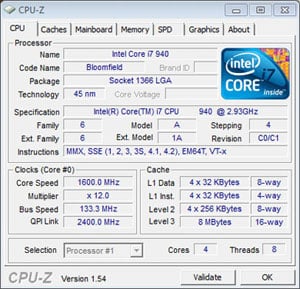For testing purposes, we've focused our system cross-reference numbers on two primary machines, both with somewhat different configurations but directly competitive GPU (NVIDIA's GeForce GTX 480M and AMD's ATI Mobility Radeon HD 5870). As a result, the view here is not a direct correlation but rather a reference point for you to consider. In our gaming test, systems are heavily GPU-dependent, so the emphasis on other subsystem components and the CPU is much less pronounced. In these tests, we have assembled as close to an "apples-to-apples" comparison as we could deliver, given the test systems available. For the PCMark Vantage, we've provided one additional reference system to give you a general view of system performance relative to Intel's previous generation CPU architecture.
|

|
|
HotHardware's Test Systems
|
|
A quick look at reference systems and specifications
|
|
|
Eurocom M98U XCaliber
- Core 2 Extreme QX9300 (2.53GHz)
- 8GB DDR3-1333
- 2x NVIDIA GeForce GTX 280M
- 120GB SSD
- Windows 7 Home Premium x64
|
Asus G73JH-A1
- Core i7 720QM 2.8GHz Turbo Mode
- 8GB DDR3-1333
- ATI Mobility Radeon HD 5870
- 2X500GB 7200RPM Hard Drive
- Windows 7 Home Premium x64
|
Clevo D900F
- Intel Core i7 940 2.93GHz
(Turbo Mode Disabled)
- 6GB DDR3-1333
- NVIDIA GeForce GTX 480M
- 2X320GB 7200RPM Hard Drive
- Windows 7 Ultimate x64
|
The CPU-Z and GPU-Z shots we have for you below show our dynamic duo in action, though the Core i7 940 processor in this notebook is throttled down in idle mode.
As you can see in the left screen capture, the Core i7 940 stock frequency identified in the spec field is 2.93GHz though its multiplier has been dropped to 12 idling on the desktop here. In the right-hand shot, details of the GeForce GTX 480M can be seen, with its 352 unified shaders, 32 ROPs, 256-bit memory bus width and a whopping 2GB of GDDR5 memory.
 |
| Futuremark PCMark Vantage |
| Synthetic General Purpose Application Performance |
|
This benchmark suite creates a host of different usage scenarios to simulate different types of general purpose computing workloads, including HDTV and movie playback and manipulation, gaming, image editing and manipulation, music compression, communications, and productivity. Most of the tests are multi-threaded as well, in order to take advantage of the additional resources offered by multi-core processors. This is the only benchmark in this article, however, that doesn't really stress the graphics processor much. Regardless, we'll offer this metric in order to set a baseline for overall system performance of the Clevo D900F notebook configuration we tested.

This test result is one you should take note of, just for a frame of reference. Bear in mind that the CPU, chipset and memory platform architecture of the Clevo D900F is that of a standard Intel X58 chipset-based system, while the Asus G73, for example, is built upon a standard notebook architecture based on the Intel PM55 Express chipset. As a result, there's no question the Clevo D900 has a distinct advantage in terms of its CPU and system memory bandwidth. However, in the heavily GPU-intensive, high resolution gaming benchmarks as we'll be covering in the pages ahead, the D900's system-level advantages would only amount to a few percentage point gain at best and perhaps in some cases where the GPU is the limiting performance factor, no measurable gain at all.










